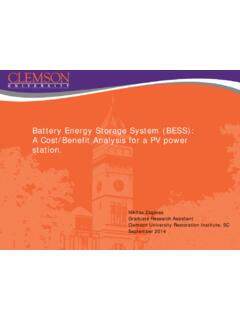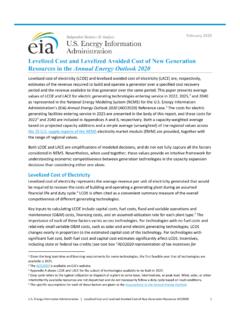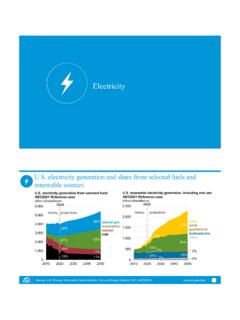Transcription of Power Plants: Characteristics and Costs
1 Order Code RL34746 Power Plants: Characteristics and CostsNovember 13, 2008 Stan KaplanSpecialist in Energy and Environmental PolicyResources, Science, and Industry DivisionPower Plants: Costs and CharacteristicsSummaryThis report analyzes the factors that determine the cost of electricity from newpower plants. These factors including construction Costs , fuel expense,environmental regulations, and financing Costs can all be affected by governmentenergy, environmental, and economic policies. Government decisions to influence,or not influence, these factors can largely determine the kind of Power plants that arebuilt in the future. For example, government policies aimed at reducing the cost ofconstructing Power plants could especially benefit nuclear plants, which are costlyto build.
2 Policies that reduce the cost of fossil fuels could benefit natural gas plants,which are inexpensive to build but rely on an expensive report provides projections of the possible cost of Power from new fossil,nuclear, and renewable plants built in 2015, illustrating how different assumptions,such as for the availability of federal incentives, change the cost rankings of thetechnologies. None of the projections is intended to be a most likely case. Futureuncertainties preclude firm forecasts. The rankings of the technologies by cost aretherefore also an approximation and should not be viewed as definitive estimates ofthe relative cost -competitiveness of each option. The value of the discussion is notas a source of point estimates of future Power Costs , but as a source of insight into thefactors that can determine future outcomes, including factors that can be influencedby the observations include the following:!
3 Government incentives can change the relative Costs of thegenerating technologies. For example, federal loan guarantees canturn nuclear Power from a high cost technology to a relatively lowcost option.!The natural gas-fired combined cycle Power plant, the mostcommonly built type of large natural gas plant, is a competitivegenerating technology under a wide variety of assumptions for fuelprice, construction cost , government incentives, and carbon raises the possibility that Power plant developers will continueto follow the pattern of the 1990s and rely heavily on natural gasplants to meet the need for new generating capacity.!With current technology, coal-fired Power plants using carboncapture equipment are an expensive source of electricity in a carboncontrol case.
4 Other Power sources, such as wind, nuclear,geothermal, and the natural gas combined cycle without capturetechnology currently appear to be more economical. ContentsIntroduction and of Generating Demand and Power Plant Choice and Operation ..3 generation and Load ..3 Economic Dispatch and Heat Rate ..4 Capacity Factor ..5 Utility Scale Generating Pulverized Coal ..7 Integrated Gasification Combined Cycle (IGCC) ..8 Natural Gas Combined Cycle ..9 Nuclear Power ..11 Geothermal Power ..11 Wind Power ..12 Solar Thermal and Solar Photovoltaic (PV) Power ..12 Factors that Drive Power Plant Costs ..13 Government Incentives ..13 Renewable Energy Production Tax energy production tax Guarantees for Nuclear and Other Carbon-Control Investment Tax Credit.
5 15 Clean Coal Technologies Investment Tax and Local Incentives ..16 Capital and Financing Costs ..17 Construction cost Components and Power Plant Projects ..19 Fuel Emissions Controls for Coal and Gas Plants ..26 Conventional Analysis Methodology and Key of Power Project Costs ..36 Case 1: Base Case ..36 Key Observations ..36 Discussion ..37 Case 2: Influence of Federal and State Incentives ..43 Key Observations ..43 Discussion ..43 Case 3: Higher Natural Gas Observations ..45 Discussion ..46 Case 4: Uncertainty in Capital Costs ..49 Key Observations ..49 Discussion ..50 Case 5: Carbon Controls and Observations ..51 Discussion ..52 Appendix A. Power generation Technology Process Diagrams and Coal ..60 Integrated Gasification Combined Cycle Coal (IGCC) ..61 Natural Gas Combined Cycle.
6 62 Nuclear Power .. Thermal Power ..68 Solar Photovoltaic B. Estimates of Power Plant Overnight Coal ..73 Integrated Gasification Combined Cycle (IGCC) Coal ..77 Nuclear ..79 Natural Gas Combined Cycle .. Photovoltaic ..92 Appendix C. Estimates of Technology Costs and Efficiency with Carbon Capture ..93 Pulverized Coal with Carbon Coal and Natural Gas Combined Cycle with Carbon D. Financial and Operating Assumptions ..96 Appendix E. List of Acronyms and Abbreviations ..101 List of FiguresFigure 1. Illustrative Load Curve ..3 Figure 2. Total Electric Power generation by Energy Source, 3. Coal and Natural Gas Constant Dollar Price Trends ..25 Figure 4. Uranium Price Trends ..26 Figure 5. EIA s Projections of S. 2191 CO2 Allowance Prices (2006$ per Metric Ton of CO2 Equivalent).
7 33 Figure 6. Comparison of EIA s Reference Case Coal Prices and S. 2191 Core Case CO2 Allowance Prices ..34 Figure 7. Natural Gas Price Trends (Henry Hub Spot Price)..47 Figure 8. Projection of Natural Gas Prices to Electric Power Plants, 2006 $ per 9. Process Schematic: Pulverized Coal without Carbon 10. Process Schematic: Pulverized Coal with Carbon 11. Representative Pulverized Coal Plant: Gavin Plant (Ohio)..60 Figure 12. Process Schematic: IGCC without Carbon 13. Process Schematic: IGCC with Carbon 14. Representative IGCC Plant: Polk Plant (Florida)..61 Figure 15. Process Schematic: Combined Cycle Power 16. Representative Combined Cycle: McClain Plant (Oklahoma)..62 Figure 17. Process Schematic: Pressurized Water Reactor (PWR)..63 Figure 18. Process Schematic: Boiling Water Reactor (BWR).
8 63 Figure 19. Representative Gen III/III+ Nuclear Plant: Rendering of the Westinghouse AP1000 (Levy County Project, Florida)..64 Figure 20. Schematic of a Wind 21. Representative Wind Farm: Gray County Wind Farm (Kansas)..65 Figure 22. Wind Turbine Size and Scale (FPL Energy) ..66 Figure 23. Process Schematic: Binary Cycle Geothermal 24. Representative Geothermal Plant: Raft River Plant (Idaho)..67 Figure 25. Process Schematic: Parabolic Trough Solar Thermal 26. Representative Solar Thermal Plant: Nevada Solar 27. Nevada Solar One: Parabolic Collector 28. Process Schematic: Central Station Solar Photovoltaic 29. Representative Solar PV Plant: Nellis Air Force Base (Nevada)..69 Figure 30. Nellis AFB Photovoltaic Array of TablesTable 1. Shares of Total National Electric generation and Generating Capacity, 2.
9 Emission Controls as an Estimated Percentage of Total Costs for a New Pulverized Coal Plant ..30 Table 3. Estimates of the Change in IGCC Plant Capacity and Capital cost from Adding Carbon 4. Estimated Base Case 5. Benchmark Comparison to Natural Gas Combined Cycle Plant Power Costs : Base Case 6. Effect of Public Power Financing on Base Case 7. Power Costs with Additional Government 8. Benchmark Comparison to Combined Cycle Power Costs : Additional Government Incentives ..45 Table 9. Benchmark Comparison to Natural Gas Combined Cycle Plant Power Costs : 50% Higher Gas Price ..48 Table 10. Change in the Base Case Gas Price Needed to Equalize the cost of Combined Cycle Power with Other 11. Effect of Higher and Lower Capital Costs on the cost of 12. Benchmark Comparison to Combined Cycle Power Costs : Higher and Lower Capital Costs .
10 51 Table 13. Effect of Current Technology Carbon Controls on Power Plant Capital cost and Efficiency ..53 Table 14. Estimated Annualized cost of Power with Carbon 15. Change in the Price of Natural Gas Required to Equalize the cost of Combined Cycle generation (Without Carbon Controls) with Other 16. cost of Power with Base and Reduced Carbon Capture cost and Efficiency Impacts ..59 Table 17. Financial 18. Power Plant Technology 19. Air Emission 20. Fuel and Allowance Price Projections (Selected Years)..1001 EIA, an independent arm of the Department of Energy, is the primary public source ofenergy statistics and forecasts for the United States. The estimated amount of newgenerating capacity is taken from the Excel output spreadsheet for the Annual EnergyOutlook 2008 report.















